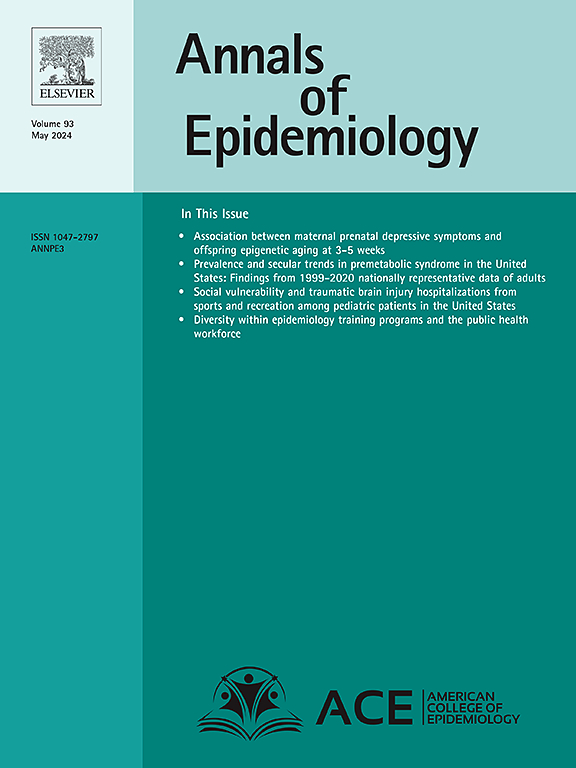A comparison of neural networks and regression-based approaches for estimating kidney function in pediatric chronic kidney disease: Practical predictive epidemiology for clinical management of a progressive disease
IF 3.3
3区 医学
Q1 PUBLIC, ENVIRONMENTAL & OCCUPATIONAL HEALTH
引用次数: 0
Abstract
Purpose
Clinical management of pediatric chronic kidney disease requires estimation of glomerular filtration rate (eGFR). Currently, eGFR is determined by two endogenous markers measured in blood: serum creatine (SCr) and cystatin C (CysC). Machine learning methods show promise to potentially improve eGFR, but it is unclear if they can outperform regression-based approaches under clinical constraining requiring real time measurement and only two predictors. We constructed a neural network for eGFR (NNeGFR) and compared it to the clinical standard Under 25 (U25eGFR) equations using the same data for training and validation.
Methods
The U25eGFR data comprised 1683 training and 843 validation observations that included iohexol measured GFR (mGFR), SCr and CysC. Sex-stratified feed forward NNs included the same predictors as U25eGFR (i.e., age, height/SCr, CysC) with additional nonlinear transformations. Performance was evaluated by bias (for calibration), proportions within 10 % and 30 % of mGFR (P10 and P30, for accuracy), root mean square error (RMSE, for precision) and R2 (for discrimination).
Results
NNeGFR performed comparably to the U25eGFR equations on all metrics. Biases were minimal, slightly favoring U25eGFR. NNeGFR and U25eGFR had similar P10 (>37 %), P30 (>86 %) and RMSE.
Conclusions
NNeGFR performed as well as established equations to estimate GFR. Without additional biomarkers related to kidney function, which are not currently clinically available in real time, NN methods are unlikely to substantially outperform regression derived GFR estimating equations. Implications for translation of these advanced epidemiologic methods to clinical practice are discussed.
神经网络与基于回归的儿童慢性肾病肾功能评估方法的比较:进展性疾病临床管理的实用预测流行病学
目的儿科慢性肾病的临床治疗需要估算肾小球滤过率(eGFR)。目前,eGFR 是通过测量血液中的两种内源性标记物来确定的:血清肌酸(SCr)和胱抑素 C(CysC)。机器学习方法有望改善 eGFR,但在需要实时测量和只有两个预测指标的临床条件下,机器学习方法能否优于基于回归的方法,目前尚不清楚。我们为 eGFR(NNeGFR)构建了一个神经网络,并使用相同的数据进行训练和验证,将其与临床标准的 25 岁以下(U25eGFR)方程进行比较。性别分层前馈 NN 包括与 U25eGFR 相同的预测因子(即年龄、身高/SCr、CysC)和额外的非线性变换。通过偏差(校准)、mGFR 10% 和 30% 以内的比例(P10 和 P30,表示准确度)、均方根误差(RMSE,表示精确度)和 R2(表示区分度)对性能进行评估。偏差极小,U25eGFR 稍占优势。结论NeGFR与U25eGFR的P10(37%)、P30(86%)和RMSE相似。如果没有更多与肾功能相关的生物标记物(目前临床上还无法实时获得这些标记物),NN 方法不太可能在很大程度上优于回归得出的 GFR 估算方程。本文讨论了将这些先进的流行病学方法应用于临床实践的意义。
本文章由计算机程序翻译,如有差异,请以英文原文为准。
求助全文
约1分钟内获得全文
求助全文
来源期刊

Annals of Epidemiology
医学-公共卫生、环境卫生与职业卫生
CiteScore
7.40
自引率
1.80%
发文量
207
审稿时长
59 days
期刊介绍:
The journal emphasizes the application of epidemiologic methods to issues that affect the distribution and determinants of human illness in diverse contexts. Its primary focus is on chronic and acute conditions of diverse etiologies and of major importance to clinical medicine, public health, and health care delivery.
 求助内容:
求助内容: 应助结果提醒方式:
应助结果提醒方式:


